Artists’ Black and White Ball
Black and White Ball
D.H. Souter, who supervised the decorations for the 1923 artists’ ball, described it as a ‘jazz fantasy’.  It was at this ball that the famous poet, writer and Queen of Bohemia, Dulcie Deamer, wore her cavewoman outfit. The photograph of Deamer dressed in a wrap-around leopard skin hide complete with a dogtooth necklace has come to symbolize the joi de vivre of the decade, despite Deamer’s own protest regarding its relevance.
It was at this ball that the famous poet, writer and Queen of Bohemia, Dulcie Deamer, wore her cavewoman outfit. The photograph of Deamer dressed in a wrap-around leopard skin hide complete with a dogtooth necklace has come to symbolize the joi de vivre of the decade, despite Deamer’s own protest regarding its relevance.
Perhaps the most notorious of the artists’ balls of this decade was held at the Sydney Town Hall in 1924.
![]()
![]() [The following 4 cartoonists drew themselves as their idea of how they will attend the Artists’ Ball to-night].
[The following 4 cartoonists drew themselves as their idea of how they will attend the Artists’ Ball to-night].
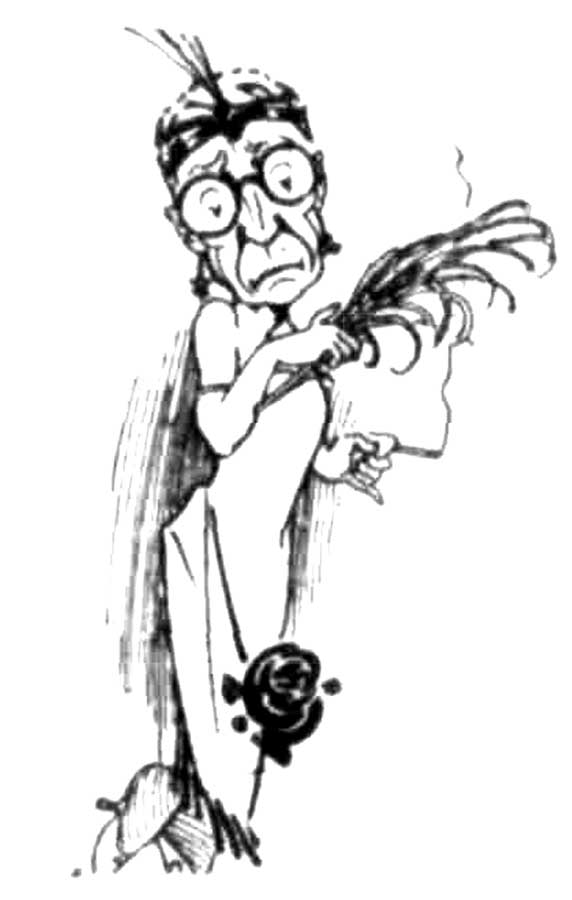
David Souter
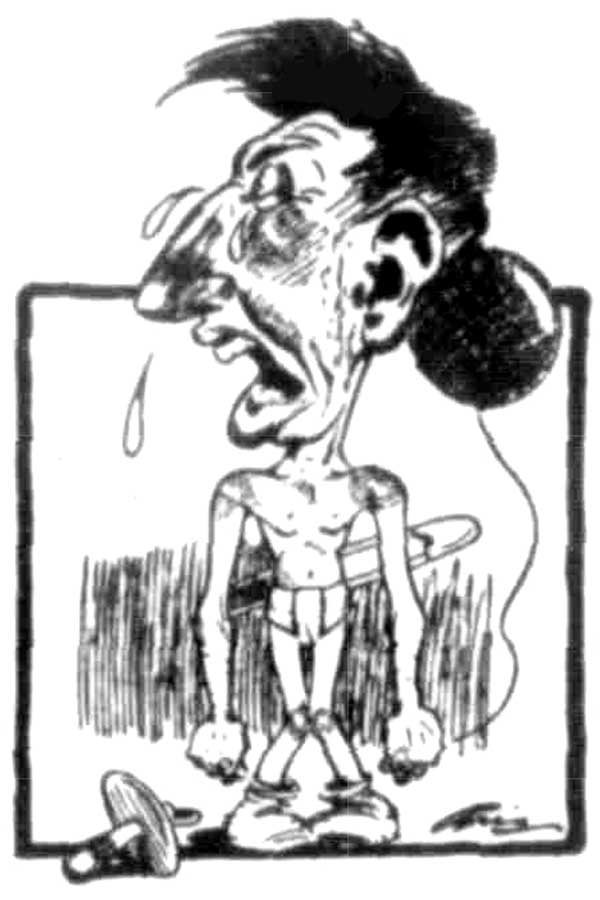
Aub Aria
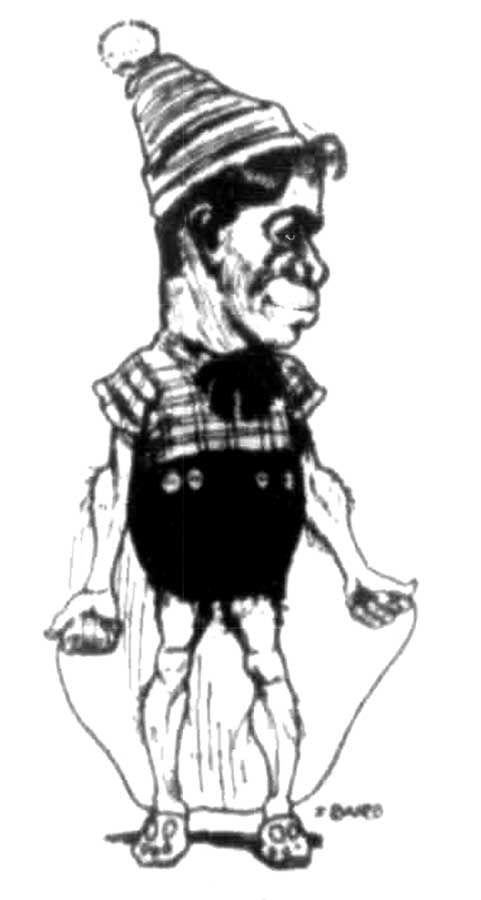
Jack Baird
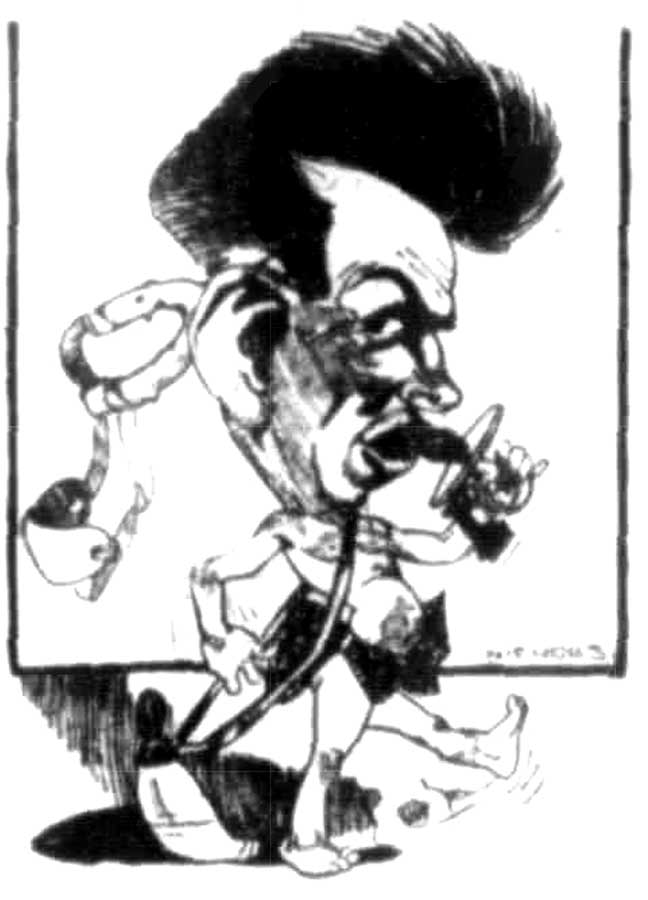
Syd Nicholls
The ball turned, if not into an orgy, then into a veritable bacchanalia: alcohol flowed freely and spirits were smuggled in in great numbers. Deamer called it the ‘Night of the Great Scandal’.
The theme of this ball was ‘Back to Childhood’. In the basement of the Town Hall the floor was covered in beer. Fights erupted after gatecrashers climbed through the basement windows, and extra police and the fire brigade were eventually called to clear the overcrowded basement which was littered with drunken semi-naked women, broken crockery and high spirited revellers. The Lord Mayor’s orderly, Martin Carrick, reported that…
in one place I saw a helpless man and woman vomiting into each other’s laps, and in the Ladies Rest Rooms men were entering with women and locking themselves in the compartments.
Beck, Deborah, Scandalous nights – Sydney’s artists’ balls, Dictionary of Sydney, 2013
Sydney was scandalised and outraged – as the following newspaper reports indicate! Future Artists’ balls in Sydney were much tamer affairs. An amusing account of the conflicted security preparations for the 1925 ball is below also. Please note that “irruption of hoolignism” and “orgie” are terms no longer used in Oz.
THE ARTISTS’ BALL
The orgiastic scenes in the basement of the Town Hall at the Artists’ Ball have amazed and shocked the people of Sydney. There is, naturally, an effort to fix the blame and there is some acrid criticism between the three authorities that were more or less in charge of the affair— the committee, the Town Hall officials, and the police. The dominant fact, however, is that all three were taken by surprise. No one on the committee, no one on the Town Hall staff, and no one in the police foresaw that such an irruption of ‘hooliganism’ would take place. The offensive was, consequently, stronger than the defensive, and disorder, stimulated by raw whisky, ran riot.
Sydney is a great city, and her population of a million is mathematically certain to include a fairly large percentage of lawless individuals who are eager to take advantage of any weakness of authority. These saw their chance on Friday night last, and took it. The obvious remedy is to ensure unified and efficient control of all functions where an outbreak of lawlessness of any kind is to be feared. The committee of the Artists’ Ball has wisely decided to limit admission to the next Ball— if any — and also to have it on one floor.

The police and the Town Hall authorities can also be trusted to evolve adequate precautions against any repetition of lawlessness.
There is one feature, however, which is outside the control of dance committees, or civic officials, or the police. The worst aspects of the orgie at the Town Hall were due to the fact that so many young girls are willing to drink not only beer but whisky — and that so many men are willing to ply them with alcohol. It would be hypocritical to say that this was something special to the Ball; it is well known that the orgie in the basement was only a demonstration in public of what is going on to some extent day and night in Sydney, as in every other great city. The disquieting fact, which all parents, all the Churches, and all who care for the welfare of the community, should face, in that a not inconsiderable section of the younger generation appear to have broken away from all restraint and to care for nothing than pleasure, sometimes in its most dangerous forms. That is the terrible truth which underlies not only the ‘hooliganism’ at the Town Hall but a thousand minor symptoms of the great moral malady.
Evening News (Sydney, NSW : 1869 – 1931), Tuesday 2 September 1924, page 6
 AN ‘ARTISTS’ BALL
AN ‘ARTISTS’ BALL
Strange and weird happenings are not uncommon in the expansive Harbour City, but rarely have the public been given such occasion for astonishment and indignation as by the proceedings which were described in a telegram in ‘The Register’ on Wednesday. The sensational facts have been made public from reports by the police authorities and town hall officials. The annual artists’ ball was held in the town hall on August 29, and attracted a crowded and ‘mixed’ company. Large quantities of wine, beer and spirits were somehow made available, apparently from the outset of the programme, and, according to Inspector Mankey, a considerably proportion of the merry-makers long before midnight had imbibed much too freely and were behaving outrageously. To an appalling extent the so-called ‘ball’ degenerated into an orgy of dissipation. In the main room of the basement about 1,000 men and women were assembled, and fully 500 of them showed ‘unmistakable signs of drunkenness.’ Indescribable scenes of debauchery and wantonness were enacted and the corridors and lavatories presented most repulsive sights. An attempt has been made to place the blame for the shocking scandal upon a body of larrikins, who entered the hall uninvited; but the police state that there were not more than a score of such interlopers, and the promoters cannot thus clear themselves of responsibility which properly attaches to them. Visitors to the Motherland are wont to state that there is no drinking in public houses by women in Australia as may be seen in the centres of population in Britain; but at . this ‘ball’ numbers of women and girls indulged freely in intoxicants, and acted in a most unseemly manner. The Police Inspector mentions having seen a girl about 18 years of age stretched full length on the floor, helplessly drunk. He saw young women in fancy dress who seemed to have lost all sense of modesty and decency. The circumstances raise disquieting questions. The engagement was an ‘artists’ ball! An inference from Mr. Larkins’ speech is that the impression widely prevails in Sydney that unrestrained Bohemianism must be created to establish the true artist. Thus, an estimate may be the more readily formed of the quality and nature of the special brand of so-called ‘art’ which has earned popularity in Australia’s greatest city.

‘By their fruits ye shall know them.’
The glorification of debasing sexual passion, so blatantly evident in numerous etchings which have been prominently before the public recently, must inevitably produce a harvest of effects. This precious ‘artists’ ball’ may help to enable Australia the better to realize the folly of supposing that perfection of artistic technique can convert what is essentially bad into something desirable.
Register (Adelaide, SA : 1901 – 1929), Thursday 4 September 1924, page 8
The following year, 1925, saw cautious vetting and security was substantially beefed up!!
CENSORS OF VARIETY
In selecting the censors for the Black and White Artists’ Ball at the Palais Royal on September 29, the committee has apparently determined that the light-hearted approval of Miss Maude Fane, Mr. Maurice Diamond, and Mr. S. Baker will be counterbalanced by the weight of a King’s CounseL in Mr. W. J. Curtis and the gravity of Mr. T. Mutch, M.L.A., and Mr, Stuart Doyle. If Miss Fane’s kind heart is moved to allow an apparently ineligible guest to pass the portals, Mr. Curtis and his companions are expected to frown such stern disapproval that Mr. Diamond and Mr. Baker will fall in behind them. In any case, the Royal Alexandra Hospital for Children should benefit largely, and nobody doubts that there will be a full supply of the fun of the fair.
Daily Telegraph (Sydney, NSW : 1883 – 1930), Tuesday 15 September 1925, page 2
How Palais Royal Staff Will Control Sydney Black-and-White Artists’ Ball
100 SPECIAL POLICE WILL ACT AT FIRST SIGN OF ROWDYISM AND EJECT OFFENDERS
THERE’S not going to be any miniature riots at the artists’ ball this year, or any drunken orgies such as have disgraced the balls of previous years. That is if J. C. Bendrodt is going to have anything to say in the control of the function — and he looks like occupying the position of Chief Controller, with a force of 100 huskies to back up his say-so.
Bendrodt intends to make this year’s ball one that a man will be able to take his wife or daughter to without their finer feelings being offended. And every decent minded man and woman will back him up in his attitude.
 There’ll be no struggling crowds fighting their way up and down the stairs — because there aren’t any stairs at the Palais Royal where the ball will be held on Tuesday week. There won’t be any drunken, disgraceful scenes in the basement, with drink sodden men and women lying about on the floor because there isn’t any basement, and there’ll be no free drinks for the jazzers. And there won’t be any rowdyism — not for more than a moment or two anyhow — because, last, but not least, Bendrodt will have a force of 100 special police who will act swiftly and efficiently at the first sign of hoodlumism and the offender will find himself in the cold darkness of the outside world before be has had time to realise that he has been in the hands of the efficient Palais Royal force. Just look at the picture on this page if you wish to see the type of men that they are. Just remember that their ranks include half-a-dozen professional pugilists, and a couple of ex-members of the North-West Mounted Police, and then decide if you wish to try conclusions with them.
There’ll be no struggling crowds fighting their way up and down the stairs — because there aren’t any stairs at the Palais Royal where the ball will be held on Tuesday week. There won’t be any drunken, disgraceful scenes in the basement, with drink sodden men and women lying about on the floor because there isn’t any basement, and there’ll be no free drinks for the jazzers. And there won’t be any rowdyism — not for more than a moment or two anyhow — because, last, but not least, Bendrodt will have a force of 100 special police who will act swiftly and efficiently at the first sign of hoodlumism and the offender will find himself in the cold darkness of the outside world before be has had time to realise that he has been in the hands of the efficient Palais Royal force. Just look at the picture on this page if you wish to see the type of men that they are. Just remember that their ranks include half-a-dozen professional pugilists, and a couple of ex-members of the North-West Mounted Police, and then decide if you wish to try conclusions with them.
You see, said Mr. Bendrodt, we look upon ourselves as a barrier between the artists and those who would blacken their name. And I’ll say we are going to be Bendrodt’s warning. We don’t fear anything from the artists themselves or their friends. If the artists were giving a private ball we would send our staff home, but the unenviable experience of the last two years has shown us that there is an objectionable section that seizes on the artists’ ball as the opportunity for drunkenness and disgraceful behaviour. ‘We are fully determined to see that the objectionable incidents which characterised the last two artists’ balls do not occur again at the Palais Royal. And we are capable of seeing that our intentions are put into effect.

I intend to increase the usual force of 33 house police that are always in attendance at our functions so that there will be about 100 men in attendance on the night of the artists’ ball. Each member of our uniformed police will have under him some half-dozen men in plain clothes, wearing badges. Each will have its own small section of the ballroom to supervise, and, in addition, patrols will travel round the room.
QUELLING OUTBREAKS
The manager will keep an eye on the proceedings from the stage and when he sees any disturbance in any particular section he will press a button and the number of that section will immediately appear on boards in different parts of the room. Then the whole force will quietly converge on that section and there won’t be any more disturbance!
However, I don’t want people to think that there won’t be any fun allowed. We don’t mean to range ourselves on the side of the wowsers. I don’t want the guests to think that they must preserve strict solemnity all the evening. Nothing of the sort. Let them have as much fun as they like but no orgies or riots. Anything in the way of reasonable revelry— or, perhaps, as it is an artists’ ball, even a gaiety a little more hectic than usual — won’t cause our interference. But any behaviour that would be objectionable to a reasonably-minded person will be— er— disciplined.
‘In what way?
Well, persons misbehaving will be asked to leave, and if they refuse we have the necessary force to see that they go out. Of course we should deplore the necessity of having to resort to such methods and we are looking forward to an evening unmarred by such incidents, but in case there Is need for it, we shall not hesitate to use the force we shall have prepared for just such emergencies. In other words, we shall hope for the best, but will be prepared for the worst.
As for liquor— well “Wine taketh glad the heart of man’’ and it would be a shame if there could not be anything to drink at the party. But they’ll have to bring it with them.
NO FREE BAR
There won’t be any free bar or flowing kegs of beer. And they’ll have to carry it in, all in one load, because they can’t go out once they’ve come in. If anyone goes out they’ll have to stay out, unless they pay to come in again. There’ll be fewer petting parties in the cars outside and as for inside? well, you see this hall is built so that all the people are under our eyes all the time. There are no other floors and no stairs, AND NO BASEMENTS! We intend to see that there is no other liquor available for the jazzers than what they bring with them. If we see any overindulgence in liquor we shall simply confiscate it and lock it up. Let them have their champagne by all means, but don’t let them start to bath in beer, or my men will take a hand. It might he as well to mention that it is only on occasions like this that liquor is allowed in the Palais Royal at all. On ordinary occasions the bringing of liquor into the hall is strictly forbidden.
WATCHING COSTUMES
Costumes over the odds?
Well see Bill over there. He’s a married man and his wife has six sisters. Bill will be censor of the ladies’ costumes. Anything that makes Bill blush, he’ll give the lady a dressing gown, and send her home. As for the gentlemen — I reckon any of us will be able to tell when a man has passed the limit, and he’ll be passed out — quickly! We’ve limited the number of tickets to 2000 and as this place can hold 3500 you can see that will be only a little over half-full, and the crowd will be more easily controlled. Again I want to say that I don’t anticipate any misbehaviour on the part of my friends, the artists, but there is an unlikeable section of this community that fastens itself on the artists like a fungus. We aim to remove the stigma that these people have left on the artists, as a result of the occurrences at the balls of the last two years. Our force consists of trained and picked men — trained not so much in the control of hooliganism as in the elimination of it. Their methods are primitive, but effective.
If this ball were riotous, it would be disastrous for the Palais Royal. We must handle it or our reputation goes. And we’ll handle it boys! And now, come out and see the boys.
HEFTY BOYS
So out we went and saw the boys. And very hefty, hard-bitten, hard-featured specimens of humanity they looked. Some remark was passed about the size of one of them.
Sure, he’s big said Bendrodt. But there’s one bigger than him but he’s not here today. He’s down at the gym, training for weight-lifting.
We’re going to ask for some special police on the night too, but I don’t think they’ll be needed. These, boys are capable of dealing with any situation. I’ve seen them chuck out as many as 150 some Saturday nights. They all know how to take care of themselves, and one or two of them are individually good enough for any half-dozen of the ordinary mob. I think it will be a sad night for anybody who starts anything rough.
So those gentlemen who always like to start their own private riot when they attend an artists ball had better take warning, and keep well away from the next. Otherwise if they attend, and start any of their usual games they are likely to come out very bad losers. Bendrodt’s police are like the mountains— they are most pleasant when viewed from a distance!
Truth (Sydney, NSW : 1894 – 1954), Sunday 20 September 1925, page 1
So, after all that kerfuffle, how did the 1925 ball go?
ARTISTS’ BALL
The Caricaturists AT PALAIS ROYAL
At 8 o’clock, the Palais Royal, looking its best, awaited the artists and their friends. Except for a few members of the committee of the Black and White Artists’ Ball, nobody was present but a strong force of “special police!” At 8.30 things became alive and the ball for the Royal Alexandra Hospital was in full swing! Dozens of people danced in fancy-dress, some pretty, some funny, some hideous. The caricatures of the artists by themselves, which, with black and white streamers, were added to the decorations, were exceedingly clever, Arthur Mailey’s “Now bring out yer ‘Obbs,” being notable. Adam reclined hideously over one of the entrances to the dancing floor, while Eve, more hideous still, held place of honor over another.  Souter’s cats were well in evidence. Mr. A.H. Fullwood insisted upon being known as an “alleged artist.” He wore a black velvet coat added to the usual evening dress and a goatee beard. The most amusing figure in the room was a “lady” six feet in height, wearing an evening gown of a few years ago, bare to the waist, and with a huge drooping feather in “her” hair; the most daring, a small girl in green, also with her back bare to the waist, and mostly dressed in frills; and the most extraordinary a man with a realistically -gnashed- mouth, who called himself “an accident”. “Freddie”, the pieman, with his coffee-stall, and two peanut-sellers, added innocent fun.
Souter’s cats were well in evidence. Mr. A.H. Fullwood insisted upon being known as an “alleged artist.” He wore a black velvet coat added to the usual evening dress and a goatee beard. The most amusing figure in the room was a “lady” six feet in height, wearing an evening gown of a few years ago, bare to the waist, and with a huge drooping feather in “her” hair; the most daring, a small girl in green, also with her back bare to the waist, and mostly dressed in frills; and the most extraordinary a man with a realistically -gnashed- mouth, who called himself “an accident”. “Freddie”, the pieman, with his coffee-stall, and two peanut-sellers, added innocent fun.
Daily Telegraph (Sydney, NSW : 1883 – 1930), Wednesday 30 September 1925, page 9
BLACK AND WHITE ARTISTS’ BALL FOR THE CHILDREN’S HOSPITAL
Guests were late in arriving at the Black and White Artists’ Ball at the Palais last night, in aid of the Children’s Hospital.
Former artists’ balls have lent colour to the belief that “fun does not commence until midnight.” It began last night much earIier than that hour, but later than usual for a dance of such Importance. Once the fun did start it flowed on in an uninterrupted channel. It was all healthy gaiety, unmarked by any regrettable incidents.
The “board of censors” had a strong moral effect on the dressing, for there were few “undress” costumes. Black and white fancy costumes were popular. Few masks were worn.
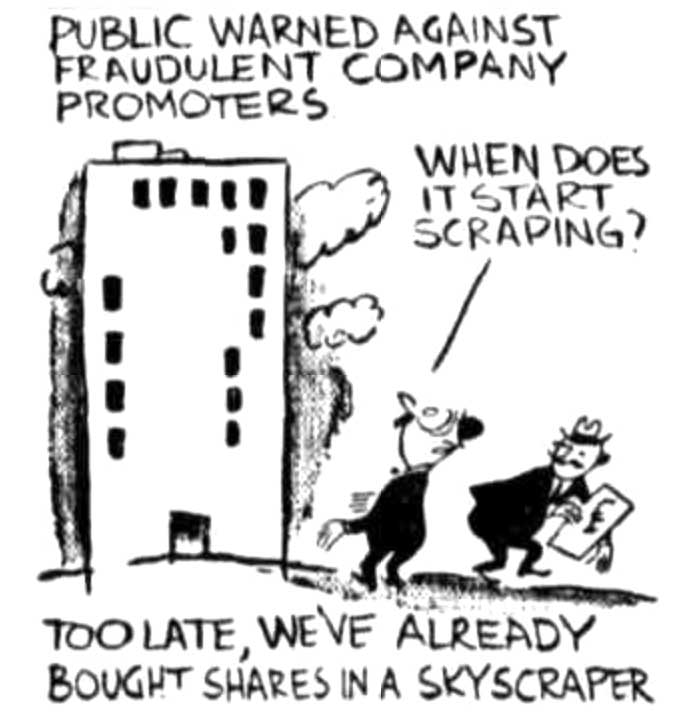
WEP (Walter Pidgeon)
The supper menu was true to name and featured “black and white” puddings. Many other delectable dishes were there also, including bread rolls, measured by the yard, pickled onions, and frankfurts, “Freddy the pieman,” with his stall, was stationed at one end of the hall, and three “peanut kings” piled their wares among the crowd.
The ordinary decorations of the Palais were retained, but an individual note was given by streamers of black and white, which fringed the inner part of the logos. Dozens of poster caricatures of members of the committee were hung on the pillars. Over the entrances huge painted figures reclined at once. “Eve” coyly playing with a serpent, confronted “Adam,” dressed in bathing trunks. “Spring” was represented as a male figure, indulging in a Bacchanalian revel.
Sydney Morning Herald (NSW : 1842 – 1954), Wednesday 30 September 1925, page 19
1927

Artists’ Ball
MANY of the revellers who attend the Black and White Artists’ Ball, to be held at the Bondi Casino on July 29, will adopt the lead of Paris, where black and white Is fashionable. The artists have called their ball ‘The Laughter Ball,’ and promise a real rollicking night of gaiety. Tickets, including supper, are one guinea.
Truth (Sydney, NSW : 1894 – 1954), Sunday 3 July 1927, page 10
ARTISTS BALL
A strong committee headed by the Lord Mayor, Messrs. Mutch, Bavin, and Colonel Bruxner, M’s L.A., A. J. R. Watt, K.C, Miss Olive Sloane, Charles Bryant, R.O.L., Henry Fullwood, R.B.A., Percy Lindsay and others has been formed for the Black and White Artists’ Ball, at the Bondl Casino, on July 29.
Sun (Sydney, NSW : 1910 – 1954), Saturday 9 July 1927, page 7
BLACK AND WHITE ARTISTS’ BALL
Mr. Scott R. Dunlop, supervising, director of Phillips Film Productions, Ltd., who has just arrived from Hollywood, will be present at the Black and White Artists Ball for the purpose of observing types which may be suitable for motion picture productions.
Sun (Sydney, NSW : 1910 – 1954), Friday 29 July 1927, page 16
Black and White Artists’ Ball
It was quite evident on Friday evening last that everybody who goes to an artists’ ball does so with the one and only intention of having a devil of a good time.
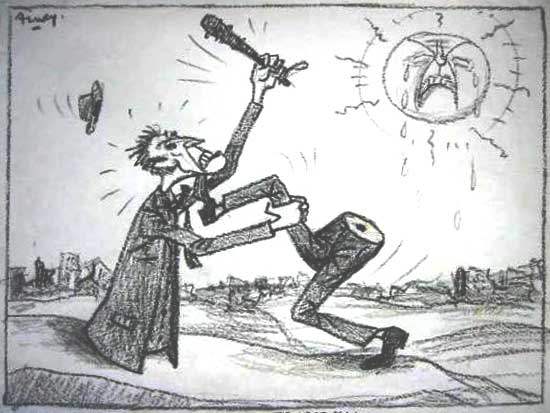
George Finey – The Last Man
Even If the programme arranged by the Black and White Artists’ committee hadn’t been an exciting one (which it was), the guests themselves would have made it so, because of the happy-go-lucky spirit they gave to tho whole affair, the really absurd costumes worn by many, and their antics apropos of same, to say nothing of the caricatures of Sydney’s notables that lined the walls. It was truly a case of fun and frolic from the moment the parade of Scots’ pipers up and down the road, outside the ballroom, drew an audience, and encouraged the revellers to ‘let her go.’ The most striking costume was worn by Miss Mary Edwards, of the Elizabethan period. It commenced with lilac frills and ended in cerise. Miss Myrtle Palotta was a graceful Columbine. The committee responsible for this most successful ball included Mr. Stan Cross (president), Mr. Cecil L. Hart [sic] (vice president), Messrs. Syd Miller, Wiseman, Armstrong, Joe Jonsson, George Finey, Ted Schofield, L. L. de Kongingh, Arthur Mailey, W.  H. Dowman, Lance Driffield, Unk White, Jack Quayle, Harry Hilling, Lew Parkes, Herman Flynn, Fred Knowles, and W. Rubery Bennett. Mr. T. D. Mutch was guest of honor, and was accompanied by Miss Grace Mutch, who wore a pink georgette frock beneath a lame coat to match. Others present were Miss Olive Sloane, who attended after the theatre, Mr. and Mrs. Stan Cross, Mr. and Mrs. Syd Miller, Mrs. Norman Lindsay, Mr. and Mrs. Cecil Hartt, Mr. and Mrs. George Finey, Mr. and Mrs. Fred Knowles, Mrs. Wally Weekes, Miss Sybil McGrath, Mrs ‘Snowy’ Howell. Miss Estelle Collier, Miss Violet Jerrams, Miss Turnbull, and Miss Lilly Reilly.
H. Dowman, Lance Driffield, Unk White, Jack Quayle, Harry Hilling, Lew Parkes, Herman Flynn, Fred Knowles, and W. Rubery Bennett. Mr. T. D. Mutch was guest of honor, and was accompanied by Miss Grace Mutch, who wore a pink georgette frock beneath a lame coat to match. Others present were Miss Olive Sloane, who attended after the theatre, Mr. and Mrs. Stan Cross, Mr. and Mrs. Syd Miller, Mrs. Norman Lindsay, Mr. and Mrs. Cecil Hartt, Mr. and Mrs. George Finey, Mr. and Mrs. Fred Knowles, Mrs. Wally Weekes, Miss Sybil McGrath, Mrs ‘Snowy’ Howell. Miss Estelle Collier, Miss Violet Jerrams, Miss Turnbull, and Miss Lilly Reilly.
Sunday Times (Sydney, NSW : 1895 – 1930), Sunday 31 July 1927, page 18
Then to 1929….
ARTISTS’ BALL
Miss Lorna Pennefather, a member of the younger set committee, is working hard for the success of the Black and White Artists’ Ball, in aid of the Picton Lakes TB Settlement, which will be held at the Paddington Town Hall on July 29. A treasure hunt will take place on Sunday to help to defray expenses. Cars will assemble outside the Art Gallery at 1030 am. and three Baby Austins will lead the way to La Corniche.
Sun (Sydney, NSW : 1910 – 1954), Tuesday 16 July 1929, page 21

BLACK AND WHITE ARTISTS’ BALL
GREAT preparations are in hand for the Artists’ Ball, which will be held at the Paddington Town Hall tomorrow evening. During the past four week-ends over twenty artists have been engaged in designing and painting the decorations, which will be a novel feature of this year’s function. There has been a splendid response for the sale of tickets, and, so as to cope with the numbers expected, the three halls attached to Paddington Town Hall have been engaged. Montgomery-Evans’ Band will dispense the music for the dancers, which will continue from 8 p.m. to 2 a.m. Tickets, 12/6, may be had from Paling’s, Nicholson’s, Australia, any artist, or from the organising secretary, Grant Hanlon, 4 Bridge-street.
Sunday Times (Sydney, NSW : 1895 – 1930), Sunday 28 July 1929, page 19

BLACK AND WHITE ARTISTS’ BALL
Striking decorations of giant grotesque figures, caricatures, and friezes massed with figures were painted by well-known black and white artists who were members of the committee of the Black and White Artists’ Ball, which was held last night at the Paddington Town Hall, to assist the funds of the Picton Lakes T.B. Settlement Scheme. This was the first ball organised by the artists tor this charity, and it is intended to make it an annual one. Six hundred guests were present, the majority of them being in fancy dress. All the dancers were masked and prizes were awarded for the most humorous and most beautiful masks.
The main ballroom and the smaller hall connected with it were transformed by bizarre sketches. Life-size caricatures of well-known artists, painted by fellow-members of the committee, adorned the pillars of the halls, and around the walls was a frieze entitled “ToyTime Revels,” depicting toy soldiers and dolls marching. Logos representing different countries, with mural decorations typical of each country, were also the work of committee members and flanked the walls both of the large and small ballrooms. Music was broadcasted into the smaller hall from the band on the dais.

Syd Miller
The Governor gave his patronage to the entertainment. Mr. Stan Cross was the president of the organising committee; Mr. D. Russell, secretary; and Messrs. Percy Benison, W. Dowman, Unk White, Ashley Cooper, J. Jonson, Fred Knowles, D. H. Souter, Leslie Board, S. Howe, Cecil Hartt, W. E. Pidgeon, W. Rubery Bennett, Syd. Miller, George Donaldson, R. Bennett, Jim Russell, A. B. Armstrong, executive. There was a younger set committee, of which Miss Shirley Tobin was the president.
Sydney Morning Herald (NSW : 1842 – 1954), Tuesday 30 July 1929, page 5


 AN ‘ARTISTS’ BALL
AN ‘ARTISTS’ BALL